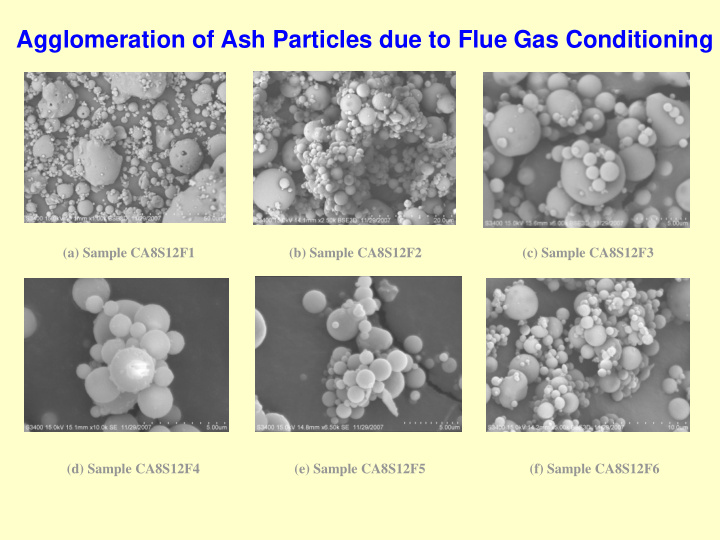



Agglomeration of Ash Particles due to Flue Gas Conditioning (a) Sample CA8S12F1 (b) Sample CA8S12F2 (c) Sample CA8S12F3 (d) Sample CA8S12F4 (e) Sample CA8S12F5 (f) Sample CA8S12F6
SEM micrographs of Silica Fumes & Ground Granulated Blast Furnace Slag (GGBFS/BFS) SF BFS
Determination of fabric structure of fine-grained soils Using SEM Compacted sample Cubic specimen Specimen preparation (Challenges): • Removal of pore fluid from the specimen without disturbing its microstructure. • Freeze-drying technique (for swelling/shrinking type of soils) • Air-drying technique (for non swelling/shrinking type of soils) • Specimen should be able to withstand the vacuum inside the microscope. • As illumination is with electrons, specimen should be made to conduct electricity. • Specimen are coated with a very thin layer of Gold or Carbon (a sputter coater). • Gold coating film can absorb X-ray signal generated into the specimen. • For obtaining X-ray spectrum of a non-conducting sample a coating material very transparent to the X-ray (Carbon) must be utilized.
Face-Face interaction Kaolinite plate stacks
Face-Edge & Edge-Edge interactions
Mercury Intrusion Porosimetry (MIP) Geomaterials are composed of wide range of particle sizes and shapes and are porous in nature. A knowledge of pore structure of these materials is important as it can give insight in to both the microstructure and the performance. Rather than measuring the porosity, It becomes more informative if the manner in which volume is distributed With respect to pore size. Inter-connected Closed Passing Dead end
Porosity Porous solids Non-porous solids medium high surface area, pore (Extremely low surface area) volume and dimension Catalysts: Particulates activated sites on porous particle size and surface area support or powder
Shape of Pores Cylindrical Slits Spherical or Interstices Ink Bottle Conical
Pore size classification and parameters Micropores: 0 < d < 2 nm (zeolites, carbons, silica fumes) Mesopores: 2 < d < 50 nm (alumina, polymers, catalysts) Macropores: 50 < d < ...nm (rocks, cements, soils, ...) Bulk, apparent and real density [g/cc] Percentage porosity [%] Pore volume/pore size distribution [pore volume vs pore size] Total pore volume [cc/g] Average pore size Specific surface area [m2/g] Particle size distribution [relative percentage vs particle size]
Characterization schemes Pore size distribution Particle size distribution Mercury porosimetry Bulk density Apparent density Total porosity Pore area distribution Low/high specific surface Gas adsorption Micro/mesopores distribution Micro/mesopores total volume Helium Pycnometry Real density
Mercury Porosimetry concept non wetting wetting • Hg is a non-wetting liquid for many solids • Hg must be forced to penetrate pores • Penetration pressure is related to pore size • Volume of Hg is related to pore volume
Hg cannot enter pores under An increasing pressure forces vacuum Hg to penetrate all accessible pores
Working principle: P = 2.( T .cos θ )/ r ……Washburns Equation Typical MIP characteristic curve Intrusion curve Extrusion curve Volume of mercury Information obtained A the pore size distribution surface area Pressure equivalent pore size A: hysterisis critical pore diameter distribution of total porosity free porosity and trapped porosity
Recommend
More recommend